![]()
![]()
![]()
Use LEFT and RIGHT arrow keys to navigate between flashcards;
Use UP and DOWN arrow keys to flip the card;
H to show hint;
A reads text to speech;
88 Cards in this Set
- Front
- Back
|
-Long-Necked Jar, Silla Kingdom, Korea, 5th C -Ceramic (stone-ware), thicker, fired at higher temperature, animal carvings |
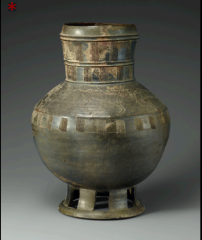
|
|
|
-Crown, Silla Kingdom, Korea, 2nd half of the 5th C -Created from hammered gold |

|
|
|
-Kudara Kanon ("Avolikitesvara from Baekje"), Horyuji (temple in Nara, Japan, Asuka period 7th centruy)
-Kanon - bodhisattva |
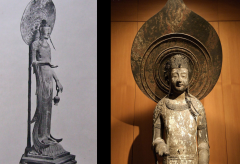
|
|
|
Bodhisvattva in pensive pose (Maitreya), Silla Kingdom, Korea, late 6th-early 7th C |
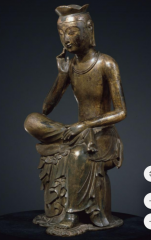
|
|
|
-International Tang Style (Longmen, Seokguram, Todaiji) -Seokguram (stone Buddha temple), granite, second hand of the 8th C, North Kyongsang province, Korea |

|
|
|
-Seokguram (stone Buddha temple), granite, second hand of the 8th C, North Kyongsang province, Korea
-monks, one bodhisattva directly behind |
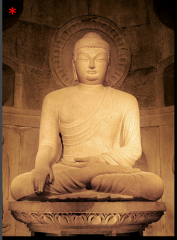
|
|
|
Seokga (Shakya) Pagoda (left) and Dabo (many treasures) pagoda (right) at the Bulguksa Temple in Gyeongju, South Korea, Silla Kingdom, Korea 751 |

|
|
|
-Wrathful Deities -Myoo (Kings of Brightness) Scroll, Heian Period, 12th C, Japan -extra hands to protect from evil, buddha on the head of the being, animal skins, emulates masculinity -connection to vajra and bell (Tibetan Buddhism) representation of opposing yet connected forces |

|
|
|
The Great Stupa at Kathmandu, Nepal |

|
|
|
-Womb Mandala, 2nd half of the 7th C, early Heian Period, Japan -Mandala: enclosed, restricted space for ritual and practice |
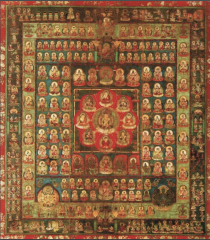
|
|
|
-Sesshu Toyo (1420-1506) Huike Offering his Arm to Bodhidharma, 1496, Japanese Depiction -Chan/Zen (originated in China, first patriarch: bodhidharama) -Bodhidharama: Buddhist monk who lived during the 5th or 6th C |
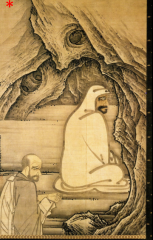
|
|
|
-The 6th Patriarch Huineng (638-713) -Mummified and lacquered body of Huineng (638-713), 6th patriarch of Chan Buddhism, Nanhua Temple, China |

|
|
|
Liang Kai, The 6th Patriarch of Chan Buddhism (Huineng) Tearing up the Sutra, 13th C, Southern Song, China |
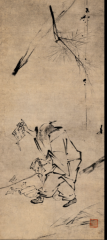
|
|
|
-Depicting the Lineage -Liang Kai (Chinese Painter), Shakyamuni (siddartha) Emerging from the Mountains, 13th C -Covering hands, depicts timelessness |

|
|
|
-Portrait of Wujun Shifan, Southern Song, 1238, China -Wujun Shifan: painter/calligrapher/prominent Sen Buddhist monk, lived during Song Dynasty -holding stick, used to wake people during meditation |

|
|
|
Attributed to Shi Ke, 10th C, Two patriarchs harmonizing their minds, Southern Song, China |
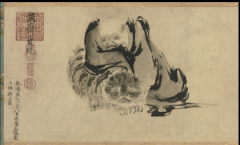
|
|
|
-Muqi Fachang (Chinese monk), Six persimmons, 13th C, Southern Song, China, Daitokoji Temple, Japan -individuality, brush work |

|
|
|
-The Admonitions Scroll of the Instructress to the Court Ladies, 6th-8th C, China -Attributed to Gu Kaizhi -Copy of 5th C work -Text from 292 C by official Zhang Hua aimed at the behavior of Empress Jia -Wire outline style |

|
|
|
-The Admonitions Scroll of the Instructress to the Court Ladies, 6th-8th C, China-Attributed to Gu Kaizhi
-Copy of 5th C work -Text from 292 C by official Zhang Hua aimed at the behavior of Empress Jia -Woman more composed then men (reflects how wives were meant to act) |
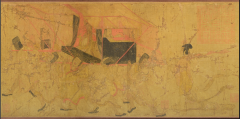
|
|
|
-The Admonitions Scroll of the Instructress to the Court Ladies, 6th-8th C, China-Attributed to Gu Kaizhi
-Copy of 5th C work-Text from 292 C by official Zhang Hua aimed at the behavior of Empress Jia -Makeup box scene - can change your image but not your character |

|
|
|
-The Admonitions Scroll of the Instructress to the Court Ladies, 6th-8th C, China-Attributed to Gu Kaizhi
-Copy of 5th C work -Text from 292 C by official Zhang Hua aimed at the behavior of Empress Jia -doing their son's hair - goal to marry sons off -triangle composition shows generations (stability) |
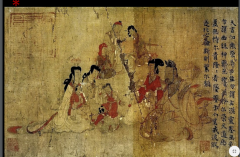
|
|
|
-The Admonitions Scroll of the Instructress to the Court Ladies, 6th-8th C, China-Attributed to Gu Kaizhi
-Copy of 5th C work -Text from 292 C by official Zhang Hua aimed at the behavior of Empress Jia -ending women moving from R to L |
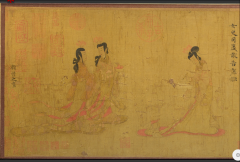
|
|
|
-The Tale of Genji Scroll, 12th C, Late Heian Period, Japan -Seiya, blue-and-green landscape ??? -Heian Period (794-1185) -The tale of Genji by Lady Murasaski Shikibu, early 11th C |

|
|
|
-The Tale of Genji Scroll, 12th C, Late Heian Period, Japan
-Yokobue (The Flute) -Heian Period (794-1185) -The tale of Genji by Lady Murasaski Shikibu, early 11th C |
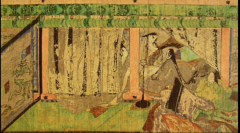
|
|
|
-The Tale of Genji Scroll, 12th C, Late Heian Period, Japan
-Yugiri ("Evening Mist") listening servants man examining writing of lover, hovering wife -fukinuki yatai style ("blow off roof") -Heian Period (794-1185) -The tale of Genji by Lady Murasaski Shikibu, early 11th C |
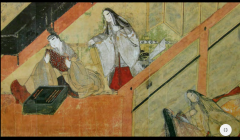
|
|
|
-The Tale of Genji Scroll, 12th C, Late Heian Period, Japan -Kasiwagi ("oak tree") -the bird's eye view without the fukinuki yatai device -Heian Period -The tale of Genji by Lady Murasaski Shikibu, early 11th C |
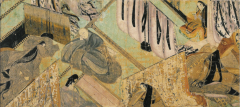
|
|
|
-Frolicking Animal Scroll (Choju Giga), mid 12th C, Japan -Folk culture (reflection of everyday culture) -Attributed to Toba Sojo -possibly related to Zen Buddhism |

|
|
|
-Frolicking Animal Scroll (Choju Giga), mid 12th C, Japan (wrestling scene)
-Folk culture (reflection of everyday culture) -Attributed to Toba Sojo -possibly related to Zen Buddhism |

|
|
|
-Frolicking Animal Scroll (Choju Giga), mid 12th C, Japan (direction change significant)
-Folk culture (reflection of everyday culture) -Attributed to Toba Sojo -possibly related to Zen Buddhism |
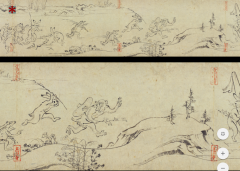
|
|
|
-Frolicking Animal Scroll (Choju Giga), mid 12th C, Japan (Buddha frog with monkey scene)
-Folk culture (reflection of everyday culture) -Attributed to Toba Sojo -possibly related to Zen Buddhism |

|
|
|
-Night Reveals of Han Xizai, 12th c copy of a 10th C painting, China -party scene, centered around performing women, furniture used as dividers -Tang Dynasty (618-907) -Han Xizai, minister to Emperor Li Yu |
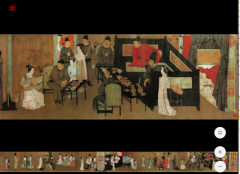
|
|
|
-Night Reveals of Han Xizai, 12th c copy of a 10th C painting, China
-party scene, centered around performing women, furniture used as dividers -Tang Dynasty (618-907) -Han Xizai, minister to Emperor Li Yu |
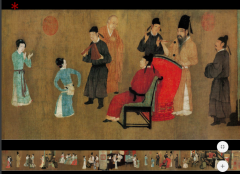
|
|
|
-Night Reveals of Han Xizai, 12th c copy of a 10th C painting, China
-party scene, centered around performing women, furniture used as dividers -Tang Dynasty (618-907) -Han Xizai, minister to Emperor Li Yu |
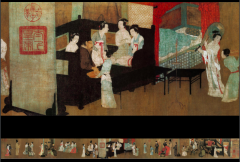
|
|
|
-Night Reveals of Han Xizai, 12th c copy of a 10th C painting, China
-party scene, centered around performing women, furniture used as dividers -Tang Dynasty (618-907) -Han Xizai, minister to Emperor Li Yu |
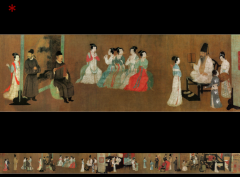
|
|
|
-Night Reveals of Han Xizai, 12th c copy of a 10th C painting, China
-party scene, centered around performing women, furniture used as dividers -Tang Dynasty (618-907) -Han Xizai, minister to Emperor Li Yu |
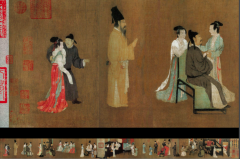
|
|
|
-Wang Xizhi, Ritual to Pray for Good Harvest, 4th, Eastern Jin, China (7th tracing copy, Tang Dynasty, China) -Wang Xizhi: "ultimate model" for calligraphy (also standard in Japan) -Resulted in tracing (even the mistakes) |
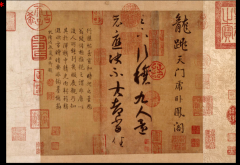
|
|
|
-Wang Xizhi, Preface to the Orchid Pavilion Gathering, 4th C, China -Legendary literary gathering took place in 353 -Tang copy of Feng Chengsu, dated to 627-50 -rubbing -Qiu Zhijie, Writing the preface to the orchid pavilion one thousand times, 1986-97 |

|
|
|
-The "slender-gold" calligraphy of Emperor Huizong, 1082-1135, Northern Song, China |
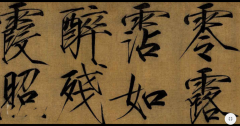
|
|
|
-Travelers Among Streams and Mountains, 1000 CE, Fan Kuan (990-1030), hanging scroll, ink on silk, Northern song, China -Important details: disappearance of mid ground, small people/cattle, grand scale, awe of nature |

|
|
|
-Early Spring, Guo Xi (ca 1001-1090), 1072, hanging scroll, ink on silk, China -Important details: Quadrants (isolating scenes), mist (pushing back and revealing landscape), S/dragon shape direction, peak represented king, crab-claw strokes (tree branches) |
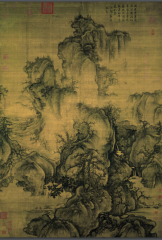
|
|
|
-Five-colored parakeet, Emperor Huizong (1082-1136), 1110-1119, Northern Song, China -Parakeet seen as rare commodity, courtly style/slender-gold calligraphy style, variety of brush work/color -xiesheng (painting from life) vs xieyi (painting from concept) -this is an example of xiesheng |
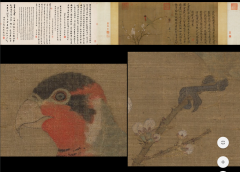
|
|
|
-Along the River During the Qingming Festival, Zhang Zeduan, 1085-1145, City of Kaifeng, China -Important details: court artist, starts with journey through the country side, climax: boat moving under the bridge, only 13 women, gates lead to city proper |

|
|
|
-Watching the Moon under the Pine, Ma yuan, Southern song, China (sometime from 1127-1279) -Important details: one-corner composition, focused push to side/the figure, trees resemble dragons, wide disappearing middle ground |
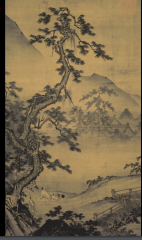
|
|
|
-A Mountain Path in Spring, Ma Yuan, 13th C, Southern Song, China -Important details: one-corner composition, intentional direction towards upper right corner (bird/writing), pairing, fogginess/isolation relating to the void |

|
|
|
-Apricot Blossoms, Ma Yuan, late 12th C, Southern Song Dynasty, China, album leafm inscription by Empress Yang (Yang Meizi)? -Important details: sexual connotations, emphasis on spring, shows different states of the flowers (relates to life cycle) |
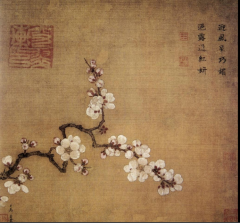
|
|
|
-Letter About a Coral Tree, Mi Fu, Ca 1101, China -Important details: emphasis on brush work, relates to Literati Culture (formal likeness vs spirit, "amateur" painters vs scholar painters, etc.) |

|
|
|
-Pure and Remote View of Streams and Mountains, Xia Gui, 13th C, Southern Song, China -Important details: tied to Literati Culture, one-corner composition, harmony, dynamic movement, axe-cut strokes on cliffs |
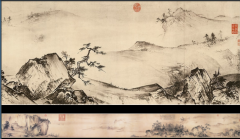
|
|
|
-Mountain Market in Clearing Mist (from eight views of xiao and xiang) , Yujian, 13th c, southern song, china |
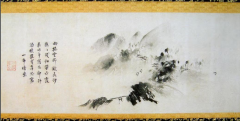
|
|
|
-Hatsuboku Landscape for Soen, Sesshu Toyo, 1495, Muromachi Period, Japan -ink splash method, considered abstract, hint of southern song tradition |

|
|
|
-Long Landscape Scroll, Sesshu Toyo, 1486, Muromachi Period, Japan -Axe cut strokes, one corner, dragon-like pine tree |

|
|
|
-Boy Pulling a Donkey, Kim Si, 16th C, Korea -Similarities to southern song paintings (composition), quick brush work, possible Buddhist implications (stubbornness) |
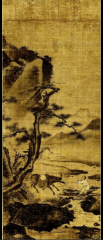
|
|
|
Southern Song Celadon |

|
|
|
-Jizhou black glaze bowl with leaf pattern, Southern Song, China -Relates to tea culture in Japan |
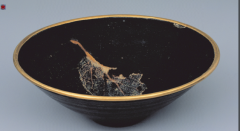
|
|
|
-Tenmuku in Japan, "Oil Spot" Jian tea bowl, Southern Song, China -Jade-like spots, copper rim -Relates to tea culture in Japan |

|
|
|
-Tenmuku in Japan, "Hare's Fur" Jian teabowl, Southern Song, China -Relates to tea culture in Japan |

|
|
|
-Celadon Wares, Ly Dynasty, 11-13th c, Vietnam -Vietnam Celadones (Ly Dynasty, 1009-1225) |
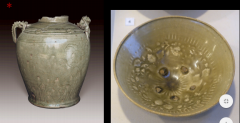
|
|
|
-Vase decorated with crane and clouds, late 13th c, Goryeo, Korea -Sanggam (inlaid celadon technique) -Korea (Goryeo Dynasty, 918-1392) |

|
|
|
-Korea (Goryeo Dynasty, 918-1392) -Sanggam (inlaid celadon technique)??? |

|
|
|
-The David Vases, 1351, Yuan Dynasty, China -Blue-and-white porcelains, 2 types of clay (china stone and kaolin) -Traded throughout world in large quantities (doesn't perish unlike silk or spice), incorporated into other cultures worldwide |
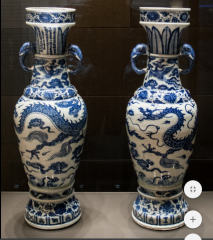
|
|
|
-Cowries container, bronze, 1st c - 3rd c, Dian Kingdom, Yunnan -Piggy bank |
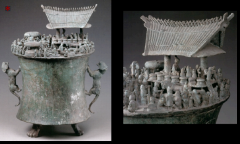
|
|
|
-Zhang Shengwen, The Long Roll, 1180 -Dali Kingdom -Stupa-like crown |
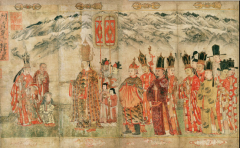
|
|
|
Bodhisattva Samantabhadra -bodhisattva in Mahayana Buddhism associated with meditation, riding elephant, posture coming from India, foot on lotus |

|
|
|
-White-robed Guanyin, Liao -Goddess worshiped before going to battle, similar face modeling to death masks -China, 907-1125??? |

|
|
|
-Guanyin of the Southern Sea, Liao or Jin (China, 900-1100??) -Wood with polychrome paint -Royal ease posture (more energy, less stern, more distinguished form of body) |

|
|
|
-Wool Flatwoven Carpet, Central Asia or China, late 13th C-early 14th C -Seen in the context of Yuan Dynasty (1215-1294) (ruling dynasty of mongols/Kublai Khan) -Related to trade -Pattern similar to Song |
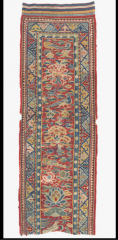
|
|
|
- Anige (1245-1306) Nepalese prince and artist summoned by Kublai Khan to serve court, built White Pagoda, 1279, Yuan Dynasty, Beijing, China |
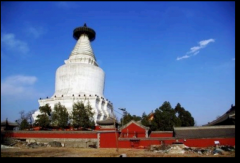
|
|
|
-Anige, Portrait of Khublai Khan, 1294, Yuan Dynasty, China/Mongol Empire -Important details: braids, fine facial hair, wearing white |
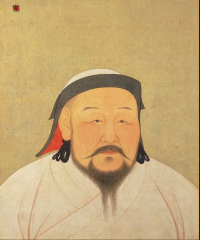
|
|
|
-Anige, Portrait of Chabi, 1294, Yuan Dynasty, China/Mongol Empire -Almost identical facial features to Khublai Khan, reinforces power, idealization of rulers |
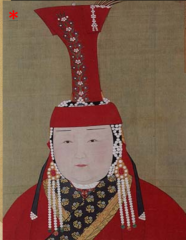
|
|
|
-Attributed to Liu Guandao (active 1279-1300), Khubilai Khan Hunting, 1280, Yuan Dynasty, China -Everything pointed at hunter -Hunter: red clothes underneath (more movement), popular gesture |
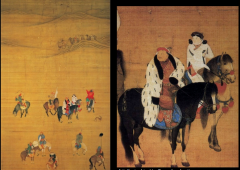
|
|
|
-Gong Kai (1222-1304), Noble Horse, Yuan Dynasty, China -Example of yimin (relates to art of political resistance, yimin= "left over people") -calligraphy similar to bones/ribs |
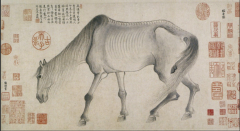
|
|
|
-Zhao Mengfu et al., Grooms and Horses, (1296-1359), Probably Yuan Dynasty, China -Important details: rump, stable, noteworthy calligraphy, painted by court artist -represents chaoyin (people who decided to accept the new court) |
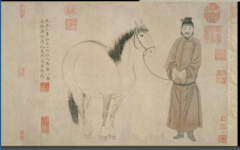
|
|
|
-Zhao Mengfun, The Mind Landscape of Xie Youyu, 1287, Handscroll, Probably Yuan Dynasty, China -Important details: Example of chaoyin (means "recluse at the court"), archaic blur and green landscape (represents a removed space and past nostalgia) |

|
|
|
-Zhao Mengfu, Graceful Rocks among Trees, Yuan Dynasty, China |

|
|
|
-Huang Gongwang, Dwelling in the Fuchun Mountains, "The Remaining Mountain", 1348-1350, Yuan Dynasty China -Important detail: 1 of the 4 masters of the yuan dynasty, influence from song, calligraphy-type strokes |
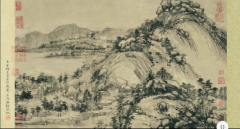
|
|
|
-Huang Gongwang, Dwelling in the Fuchun Mountains, "Master Wuyong Scroll", 1348-1350, Yuan Dynasty China
-Important detail: lived from 1269-1354, 1 of the 4 masters of the yuan dynasty, influence from song, calligraphy-type strokes |

|
|
|
-Ni Zan, Six Gentlemen, 1345, Yuan Dynasty, China -Important detail: lived from 1301-1374, 1 of the 4 master of the Yuan Dynasty |
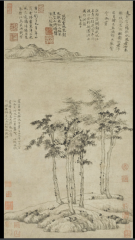
|
|
|
-Night attack on the Sanjo Palace, 2nd half of 13th c, Kamakura Period, Japan -Kamakura period from 1185-1333, established by first shogun (military dictator) Minamoto no Yoritomo |

|
|
|
-Armor, early mid 14th C, Kamakura Period, Japan -Made from iron, leather, lacquer, silk, copper, and gold -Kamakura period from 1185-1333, established by first shogun (military dictator) Minamoto no Yoritomo |
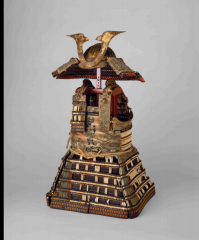
|
|
|
-Tachi, Rai Kunimitsu, 13th c, Kamakura Period, Japan -relates to samurais -Kamakura period from 1185-1333, established by first shogun (military dictator) Minamoto no Yoritomo |
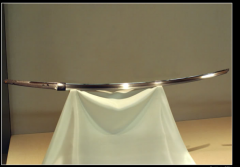
|
|
|
-Painting of the Impure Aspect of the Human Realm, late 13th c, Kamakura Period, Japan -Relates to the contemplation on the nine stages of a decaying corpse ("kusokan") -Kamakura period from 1185-1333, established by first shogun (military dictator) Minamoto no Yoritomo |
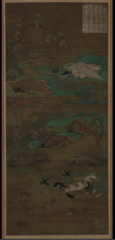
|
|
|
-Hungry Ghost Scroll, late 12th C, Heian Period, Japan |
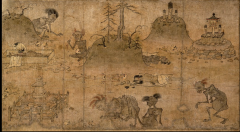
|
|
|
-Descent of Amida Buddha with 25 Bodhisattvas, 14th C, Kamakura Period, Japan - Kamakura period from 1185-1333, established by first shogun (military dictator) Minamoto no Yoritomo |
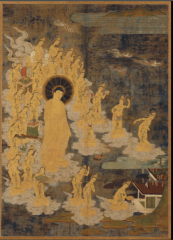
|
|
|
-Guardian figure at Sanju Sangendo Hall, Kamakura Period, Japan -Important details: part of Kei School (Japanese school of Buddhist sculpture), exaggerated muscles/veins, body parts carved separately (creates movement) - Kamakura period from 1185-1333, established by first shogun (military dictator) Minamoto no Yoritomo |

|
|
|
-Portrait of statue of the priest Shunjobo Chogen, early 13th C, Kamakura Period, Todaiji, Nara, Japan -Important details: part of Kei School (Japanese school of Buddhist sculpture), hyper-realism (can trace back to an actual person), carved out of wood, life-size - Kamakura period from 1185-1333, established by first shogun (military dictator) Minamoto no Yoritomo |
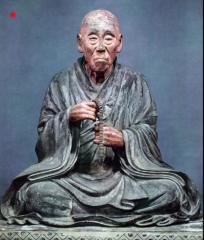
|
|
|
-Tea implements at Famen Temple, before 9th c, Tang Dynasty, China -Important Details: found in Buddha tomb with finger bones, tea used as a medicine, viewed as luxury item in society |
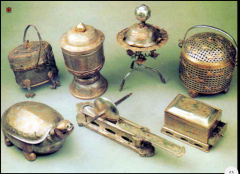
|
|
|
-Rustic-style tea house hut, 1618, built by the samurai and tea-master Oda Yuraku -Important details: represents removal, combination of clay/straw/bamboo |

|
|
|
-Astor Court, Metropolitan Museum of Art -Gardens not meant to be in museums, treated like a work of art, contrast of organic/inorganic, hard/soft, permanent/nonpermanent |
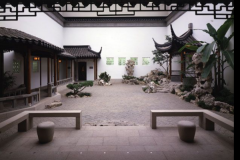
|
|
|
-The Rock Garden at Ryoanji, probably 17th c or later -Representational or about Emptiness? Zen? |

|

